Study on the Performances of Waste Battery Powder Modified Asphalt and Asphalt Mixture
Abstract
1. Introduction
2. Materials and Methods
2.1. Raw Materials
2.1.1. WBP
2.1.2. Asphalt
2.1.3. Aggregate
2.2. Preparation of WBP Modified Asphalt
2.3. Experimental Design
3. Results
3.1. FTIR
3.2. High Temperature Rheological Property
3.3. Full Section Fracture Energy
3.4. Pavement Performance of Asphalt Mixture
3.4.1. High-Temperature Stability
3.4.2. Low-Temperature Anti-Cracking Performance
3.4.3. Water Stability
4. Conclusions
- (1)
- There is no new characteristic absorption peak when WBP is mixed into asphalt, and the original characteristic peak has not disappeared. The modification of asphalt by WBP is essentially physical modification, but the mixing of WBP has a certain enhancement effect on the bond energy of the methylene group, which is helpful to improve the technical performance of modified asphalt.
- (2)
- The greater the amount of WBP, the greater the dynamic shear modulus, and rutting factor under the same scanning temperature. The proportion of elastic components in asphalt can be significantly increased by adding WBP, thus enhancing the deformation resistance of asphalt under high-temperature conditions.
- (3)
- The mixing of WBP reduces the proportion of viscous components in asphalt, which is unfavorable to the crack resistance under low temperatures.
- (4)
- The greater the amount of WBP, the greater the downward shift of the peak value of the stress-strain curve of asphalt; the envelope area of the corresponding peak value from the initial stage of the stress-strain curve to the actual stress-strain curve also decreases, and the low-temperature cracking resistance of asphalt decreases.
- (5)
- Compared with ordinary asphalt mixture, the high-temperature stability of WBP-modified asphalt mixture is significantly improved, and the water stability is slightly improved, but the low-temperature crack resistance is reduced to a certain extent.
- (6)
- Although the WBP has significantly improved the high-temperature performance of asphalt, it is far from reaching the technical level of SBS Ι-C modified asphalt, and the high-temperature stability, low-temperature crack resistance, and water stability of the WBP-modified asphalt mixture cannot reach the level of SBS Ι-C modified asphalt mixture.
Author Contributions
Funding
Institutional Review Board Statement
Informed Consent Statement
Data Availability Statement
Conflicts of Interest
References
- Taamneh, M.M.; Al-Omari, A.A.; Al-Khreisat, B.I. Investigating the potential of using dry battery waste powders (DBWPs) as a modifier for asphalt binders. J. Mater. Cycles Waste Manag. 2021, 23, 676–685. [Google Scholar] [CrossRef]
- de Sousa Neto, V.F.; Lucena, L.C.D.F.L.; de Barros, A.G.; Lucena, A.E.D.F.L.; Marinho Filho, P.G.T. Rheological evaluation of asphalt binder modified with zinc oxide nanoparticles. Case Stud. Constr. Mater. 2022, 17, e01224. [Google Scholar] [CrossRef]
- Su, M.; Si, C.; Zhang, Z.; Zhang, H. Molecular dynamics study on influence of Nano-ZnO/SBS on physical properties and molecular structure of asphalt binder. Fuel 2020, 263, 116777. [Google Scholar] [CrossRef]
- Wang, X.C.; Foley, A.; Fan, Y.V.; Nižetić, S.; Klemeš, J.J. Integration and optimisation for sustainable industrial processing within the circular economy. Renew. Sustain. Energy Rev. 2022, 158, 112105. [Google Scholar] [CrossRef]
- Zhang, Z.; Malik, M.Z.; Khan, A.; Ali, N.; Malik, S.; Bilal, M. Environmental impacts of hazardous waste, and management strategies to reconcile circular economy and eco-sustainability. Sci. Total Environ. 2022, 807, 150856. [Google Scholar] [CrossRef]
- Sultana, I.; Chen, Y.; Huang, S.; Rahman, M.M. Recycled value-added circular energy materials for new battery application: Recycling strategies, challenges, and sustainability-a comprehensive review. J. Environ. Chem. Eng. 2022, 10, 108728. [Google Scholar] [CrossRef]
- Duan, H.; Long, J.; Zhang, H.; Luo, H.; Cao, J. Effects of different carriers for zinc oxide (ZnO) particles on microstructure of ZnO/layered silicate composite and aging resistance of composite modified asphalt. Constr. Build. Mater. 2022, 349, 128773. [Google Scholar] [CrossRef]
- Zhang, H.; Zhu, C.; Duan, H. Synergetic Effect of Multi-Dimensional Nanomaterials on Aging Resistance of Asphalt. J. Test. Eval. 2020, 49, 2028–2034. [Google Scholar] [CrossRef]
- Zakieva, R.R.; Gussamov, I.I.; Gadel’shin, R.M.; Petrov, S.M.; Ibragimova, D.A.; Baibekova, L.R. Modification of petroleum bitumen by oxygen-containing compounds and transition metal oxides. Chem. Technol. Fuels Oils 2015, 51, 339–344. [Google Scholar] [CrossRef]
- Xie, J.; Chen, J.; Wu, S.; Lin, J.; Wei, W. Performance characteristics of asphalt mixture with basic oxygen furnace slag. Constr. Build. Mater. 2013, 38, 796–803. [Google Scholar] [CrossRef]
- Deng, Y.; Hu, M.; Xu, L.; Ling, S.; Ni, H.; Sun, D. Dual roles played by manganese dioxide filler in asphalt pavement material: Chemical modification and healing improvement. Constr. Build. Mater. 2022, 345, 128371. [Google Scholar] [CrossRef]
- Le, J.L.; Marasteanu, M.O.; Turos, M. Mechanical and compaction properties of graphite nanoplatelet-modified asphalt binders and mixtures. Road Mater. Pavement Des. 2020, 21, 1799–1814. [Google Scholar] [CrossRef]
- Yan, T.; Ingrassia, L.P.; Kumar, R.; Turos, M.; Canestrari, F.; Lu, X.; Marasteanu, M. Evaluation of graphite nanoplatelets influence on the lubrication properties of asphalt binders. Materials 2020, 13, 772. [Google Scholar] [CrossRef] [PubMed]
- Hu, Z.; Xu, T.; Liu, P.; Oeser, M.; Wang, H. Improvements of developed graphite based composite anti-aging agent on thermal aging properties of asphalt. Materials 2020, 13, 4005. [Google Scholar] [CrossRef]
- He, J.; Hu, W.; Xiao, R.; Wang, Y.; Polaczyk, P.; Huang, B. A review on Graphene/GNPs/GO modified asphalt. Constr. Build. Mater. 2022, 330, 127222. [Google Scholar] [CrossRef]
- Yu, X.; Zadshir, M.; Yan, J.R.; Yin, H. Morphological, Thermal, and Mechanical Properties of Asphalt Binders Modified by Graphene and Carbon Nanotube. J. Mater. Civ. Eng. 2022, 34, 04022047. [Google Scholar] [CrossRef]
- Nciri, N.; Kim, N.; Cho, N. Spent Graphite from End-of-Life Lithium-Ion Batteries (LIBs) as a Promising Nanoadditive to Boost Road Pavement Performance. Materials 2021, 14, 7908. [Google Scholar] [CrossRef]
- Zhang, W.; Zou, L.; Wang, Y.; Liu, J.; Yang, C.; Di, J.; Hu, H.; Yang, Z. Influence of High Viscosity Petroleum Resin (HV-PR) on the Intermediate and High Temperature Performances of Styrene–Butadiene–Styrene Block Copolymer (SBS) Modified Bitumen. Arab. J. Sci. Eng. 2022, 47, 12521–12533. [Google Scholar] [CrossRef]
- Wu, S.; Tahri, O. State-of-art carbon and graphene family nanomaterials for asphalt modification. Road Mater. Pavement Des. 2021, 22, 735–756. [Google Scholar] [CrossRef]
- Sheng, Y.; Wu, Y.; Yan, Y.; Jia, H.; Qiao, Y.; Underwood, B.S.; Niu, D.Y.; Kim, Y.R. Development of environmentally friendly flame retardant to achieve low flammability for asphalt binder used in tunnel pavements. J. Clean. Prod. 2020, 257, 120487. [Google Scholar] [CrossRef]
- Fan, S.; Li, C.; Xu, T. Effects of Prepared Carbon Nanofibers on Properties of Emulsified Asphalt. J. Test. Eval. 2021, 49, 4102–4117. [Google Scholar] [CrossRef]
- Zhang, W.; Qiu, L.; Liu, J.; Hu, K.; Zou, L.; Chen, Y.; Yang, C.; Wang, F.; Zang, J. Modification mechanism of C9 petroleum resin and its influence on SBS modified asphalt. Constr. Build. Mater. 2021, 306, 124740. [Google Scholar] [CrossRef]
- Wang, H.; Liu, X.; Lu, G.; Yang, J. Accelerated healing in asphalt concrete via laboratory microwave heating. J. Test. Eval. 2020, 48, 739–757. [Google Scholar] [CrossRef]
- Guo, H.Y.; Li, Y.Y.; Wang, C.L.; He, L.; Li, C.; Guo, Y.Q.; Zhou, Y. Effect of the air oxidation stabilization of pitch on the microstructure and sodium storage of hard carbons. New Carbon Mater. 2021, 36, 1073–1078. [Google Scholar] [CrossRef]
- Yoo, D.Y.; Kim, S.; Kim, M.J.; Kim, D.; Shin, H.O. Self-healing capability of asphalt concrete with carbon-based materials. J. Mater. Res. Technol. 2019, 8, 827–839. [Google Scholar] [CrossRef]
- Zhang, D.; Chen, M.; Wu, S.; Liu, Q.; Wan, J. Preparation of expanded graphite/polyethylene glycol composite phase change material for thermoregulation of asphalt binder. Constr. Build. Mater. 2018, 169, 513–521. [Google Scholar] [CrossRef]
- Zhang, W.; Zou, L.; Chen, F.; Yang, C.; Li, Y.; Yan, X.; Zang, J.H.; Liu, J. Evaluation method of storage stability of SBS modified bitumen based on dynamic rheological properties. Constr. Build. Mater. 2022, 323, 126615. [Google Scholar] [CrossRef]
- Wang, Z.; Dai, Q.; Guo, S. Microwave-healing performance of modified asphalt mixtures with flake graphite and exfoliated graphite nanoplatelet. Constr. Build. Mater. 2018, 187, 865–875. [Google Scholar] [CrossRef]
- Zhou, X.; Chen, L.; Cao, H.; Yu, J.; Qiu, G.; Wang, L. Effects of emulsified asphalt on the mechanical and tribological properties of copper/graphite composites. Mater. Res. Express 2019, 6, 056515. [Google Scholar] [CrossRef]
- Vo, H.V.; Park, D.W.; Seo, W.J.; Yoo, B.S. Evaluation of asphalt mixture modified with graphite and carbon fibers for winter adaptation: Thermal conductivity improvement. J. Mater. Civ. Eng. 2017, 29, 04016176. [Google Scholar] [CrossRef]
- Zhang, D.; Chen, M.; Wu, S.; Riara, M.; Wan, J.; Li, Y. Thermal and rheological performance of asphalt binders modified with expanded graphite/polyethylene glycol composite phase change material (EP-CPCM). Constr. Build. Mater. 2019, 194, 83–91. [Google Scholar] [CrossRef]
- Li, Y.; Hu, X.; Zhao, Y.; Zhu, G.; Wang, N.; Pan, P.; Peng, C.; Sun, Y. Performance evaluation of asphalt mixture using brake pad waste as aggregate. Case Stud. Constr. Mater. 2022, 17, e01639. [Google Scholar] [CrossRef]
- Guo, R.; Tang, J.; Gu, J.; Guo, G.; Feng, X. Analysis on the road performance of graphene composite rubber asphalt and its mixture. Case Stud. Constr. Mater. 2022, 17, e01664. [Google Scholar] [CrossRef]
- Wu, B.; Pei, Z.; Xiao, P.; Lou, K.; Wu, X. Influence of fiber-asphalt interface property on crack resistance of asphalt mixture. Case Stud. Constr. Mater. 2022, 17, e01703. [Google Scholar] [CrossRef]
- The Ministry of Communications Highway Science Institute. Technical Specification of Construction of Highway Asphalt Pavement; JTG F40-2004; China Communications Press: Beijing, China, 2004. (In Chinese) [Google Scholar]
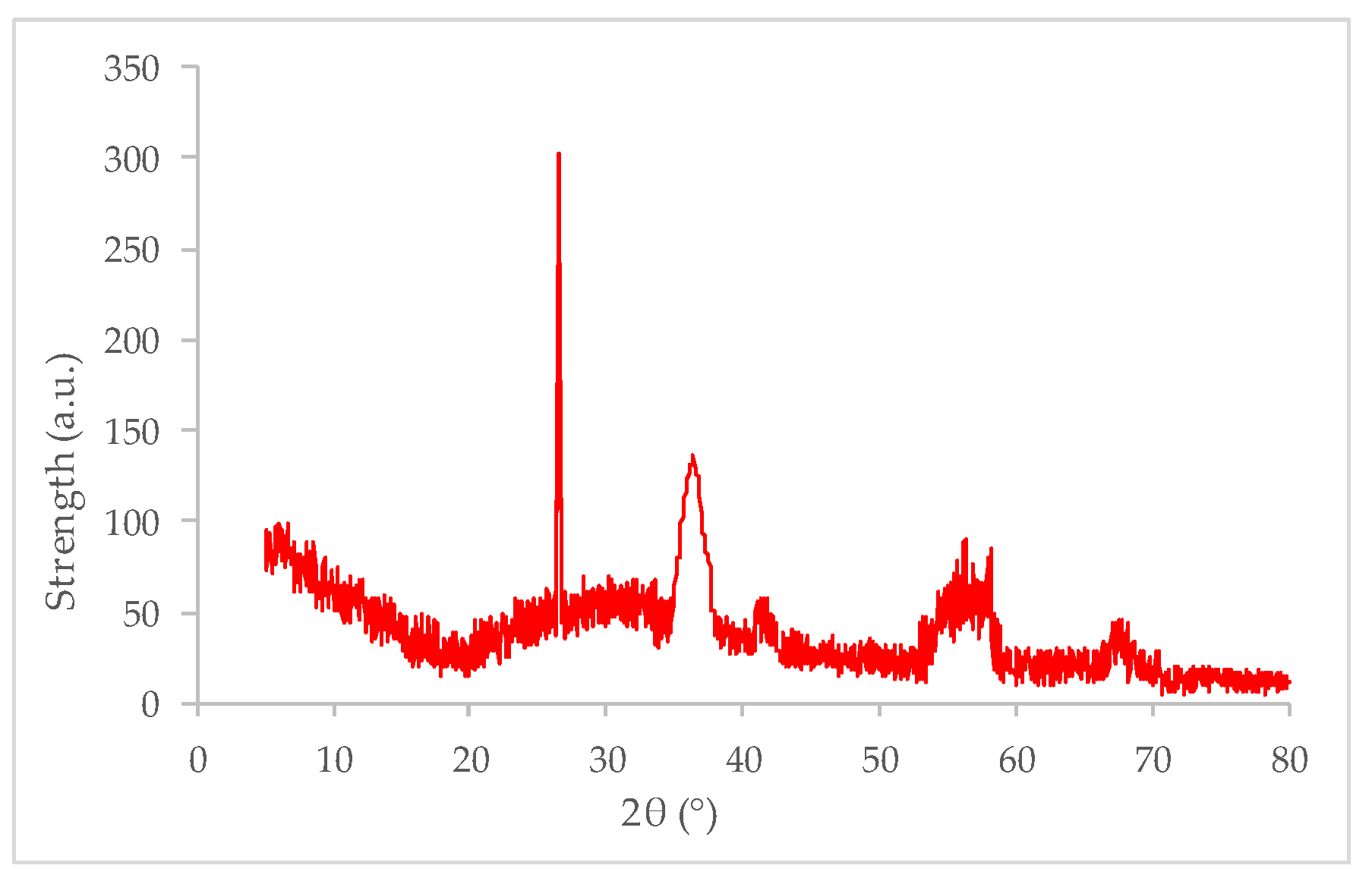
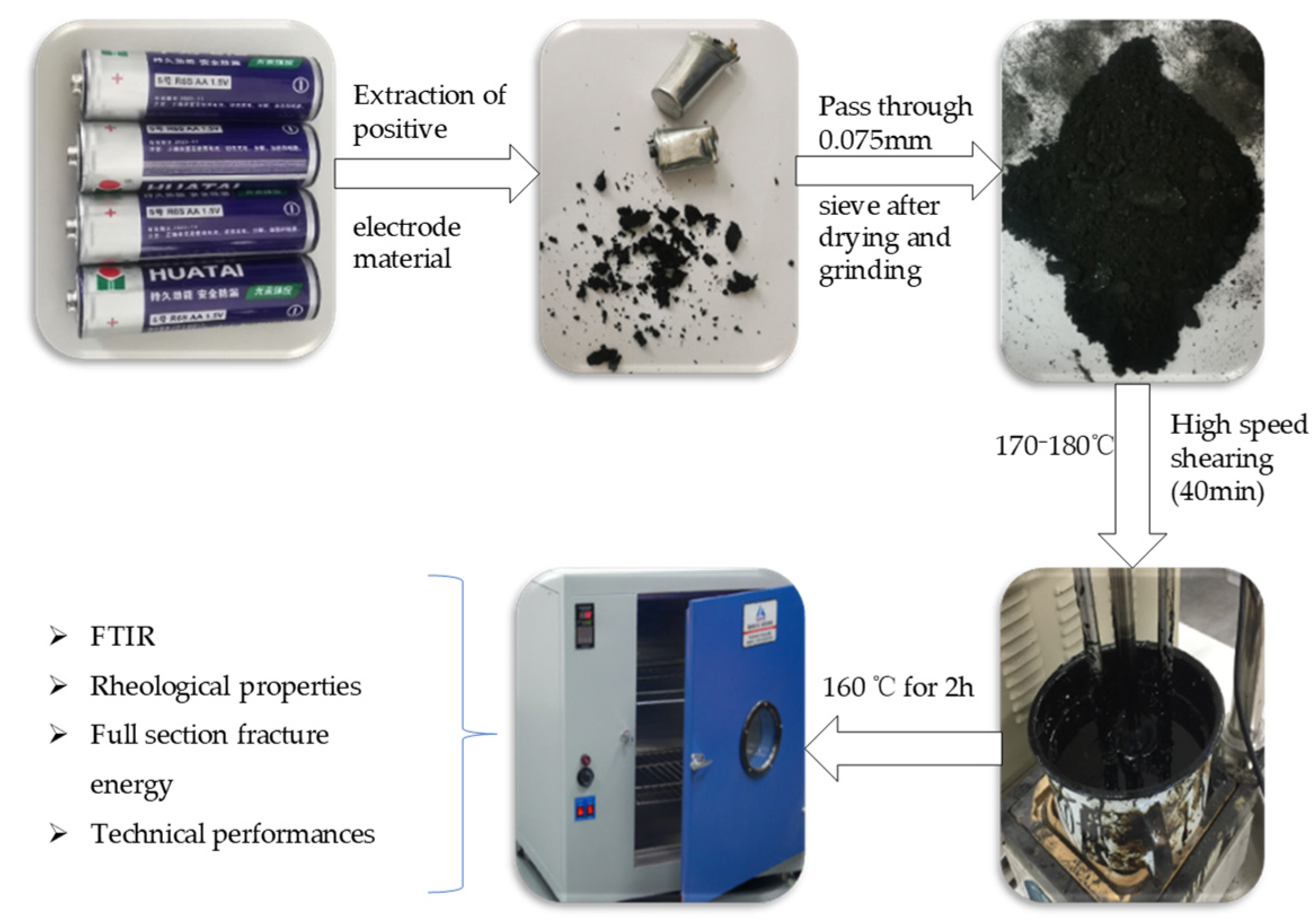
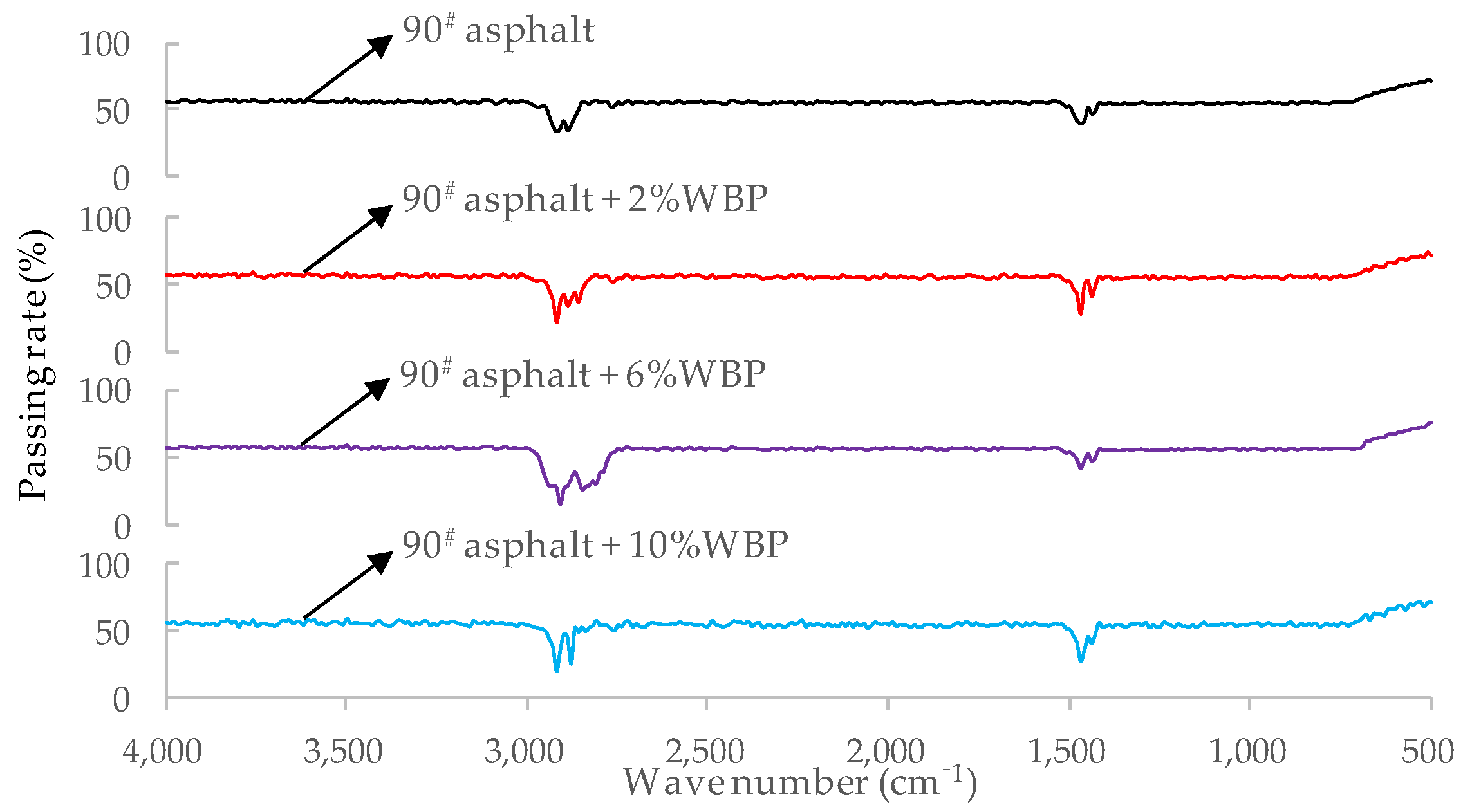
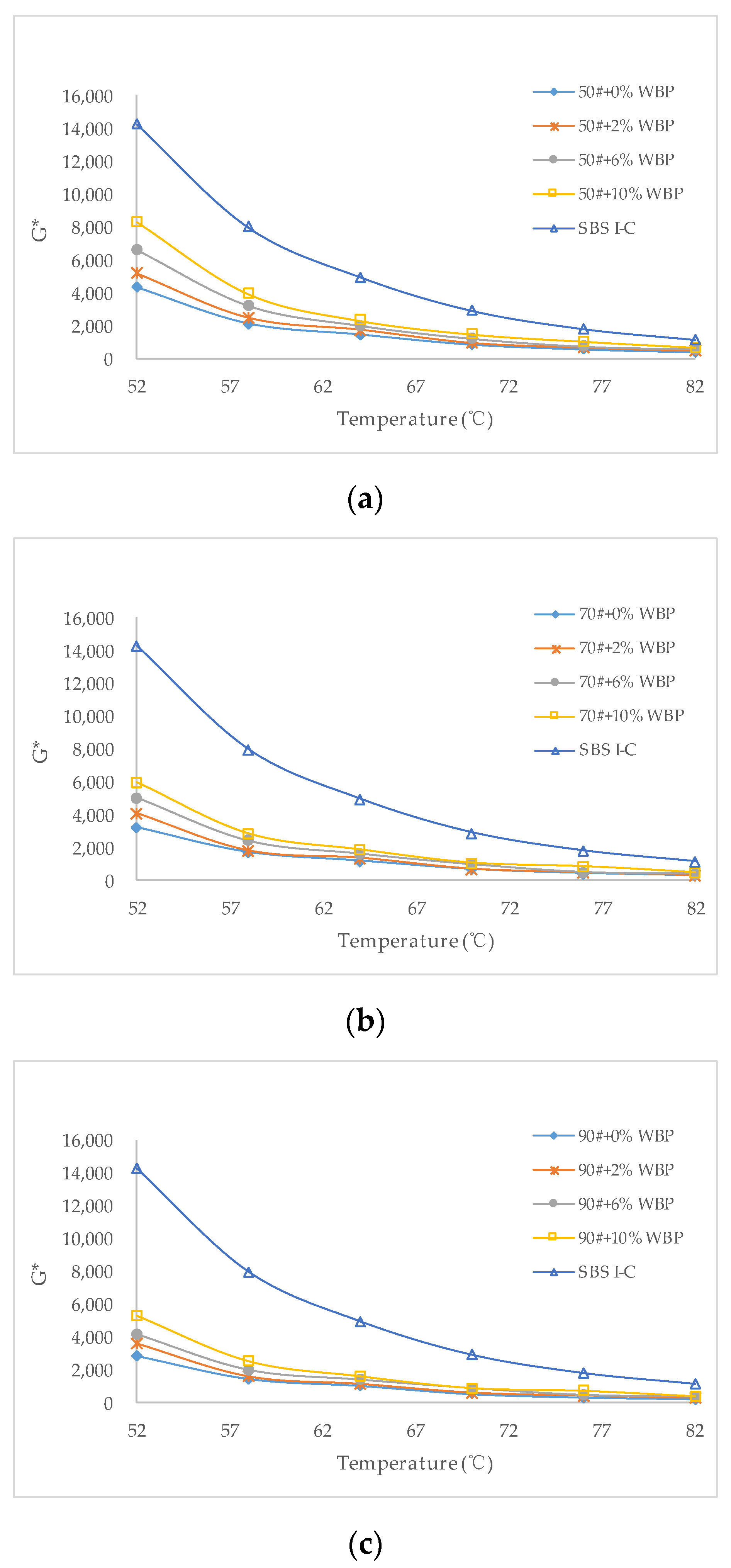
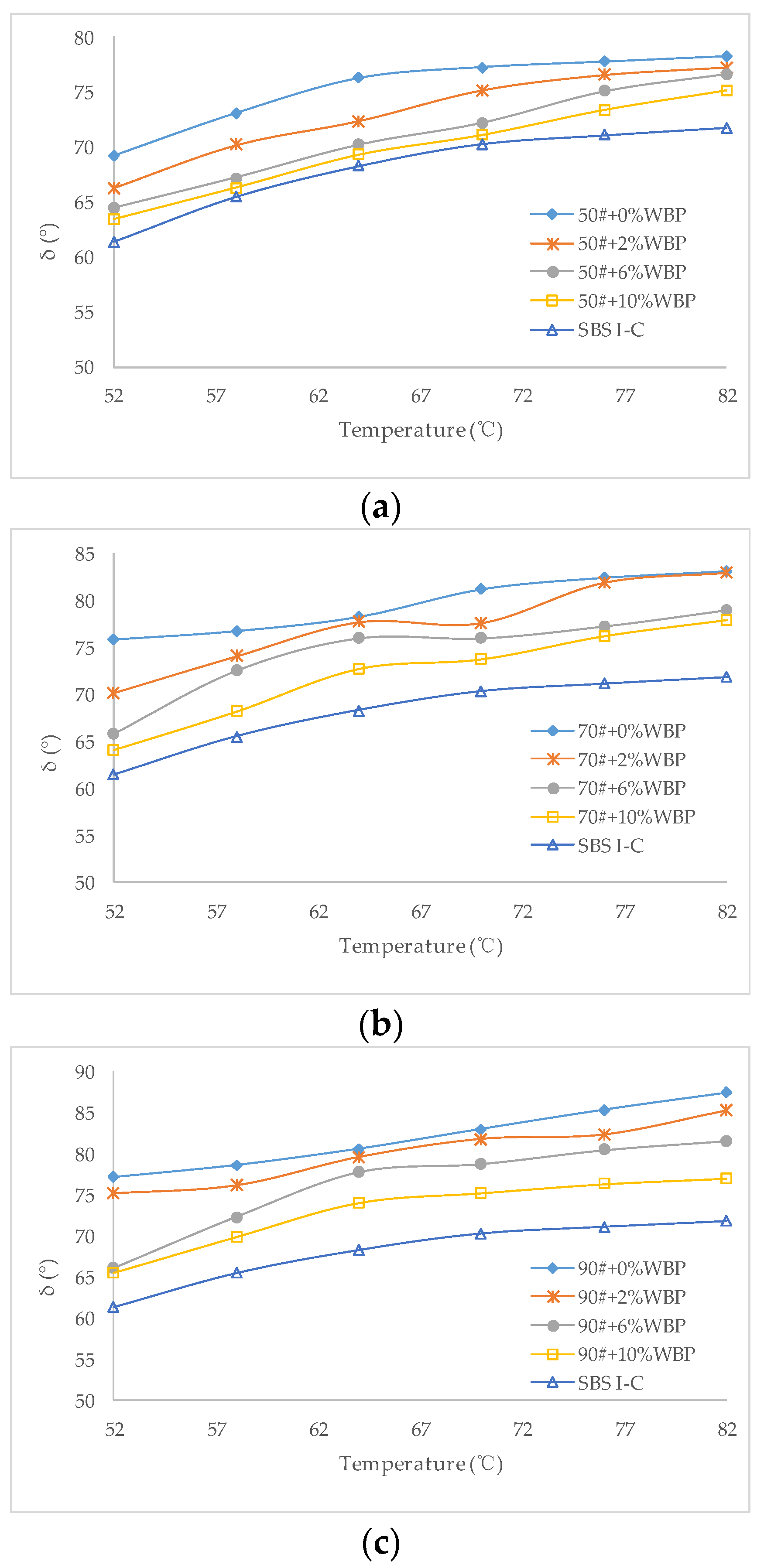
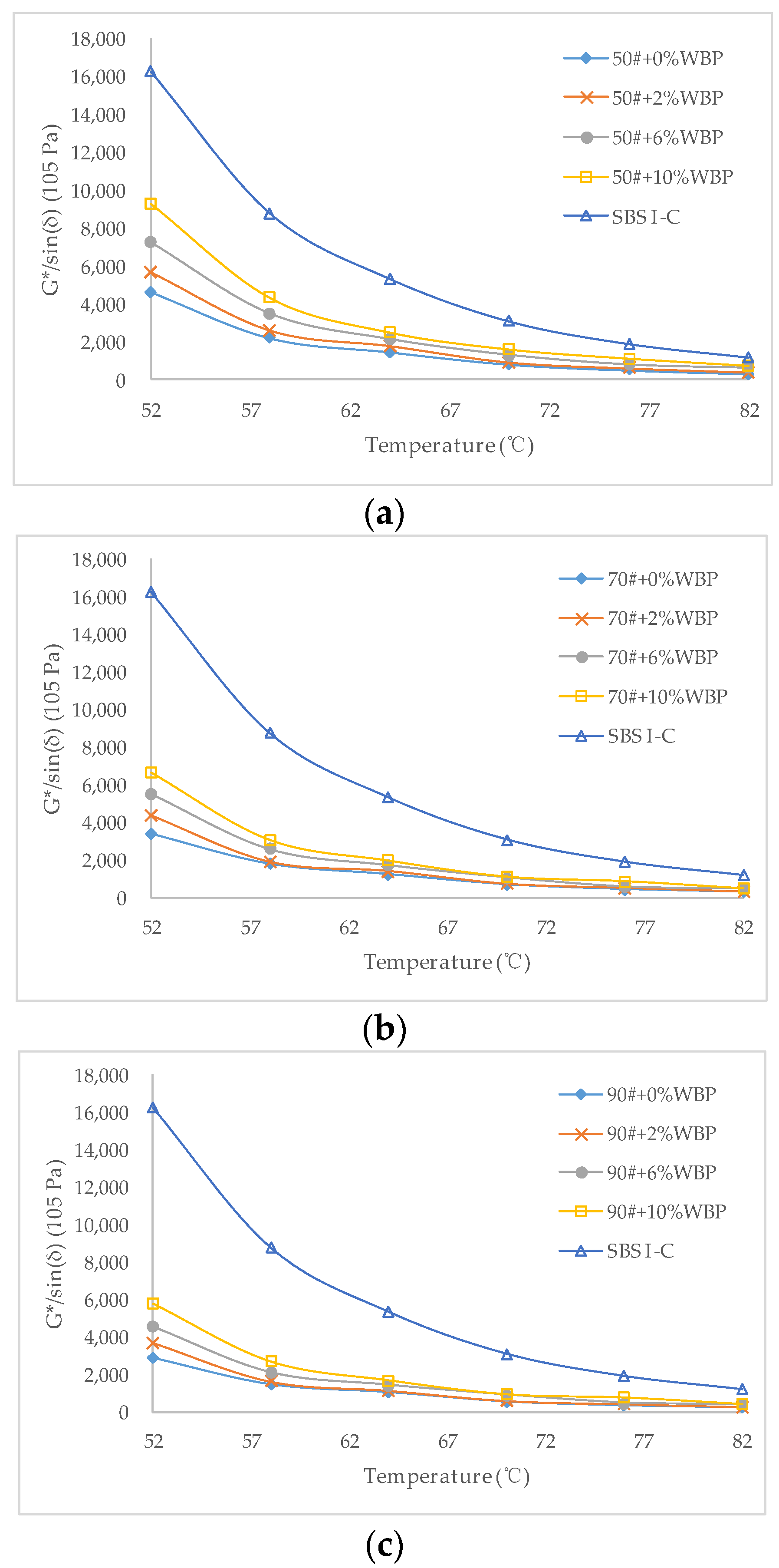
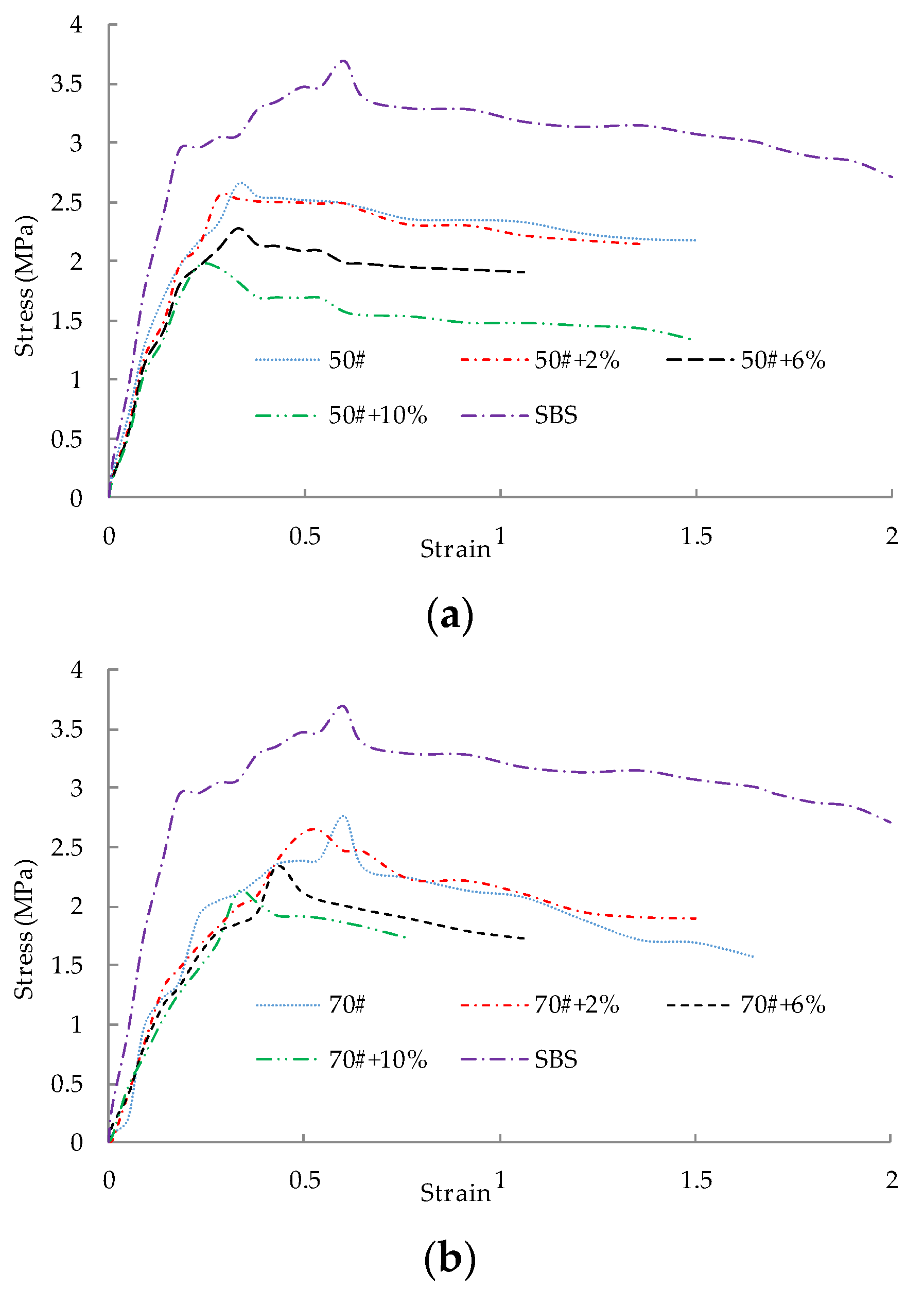
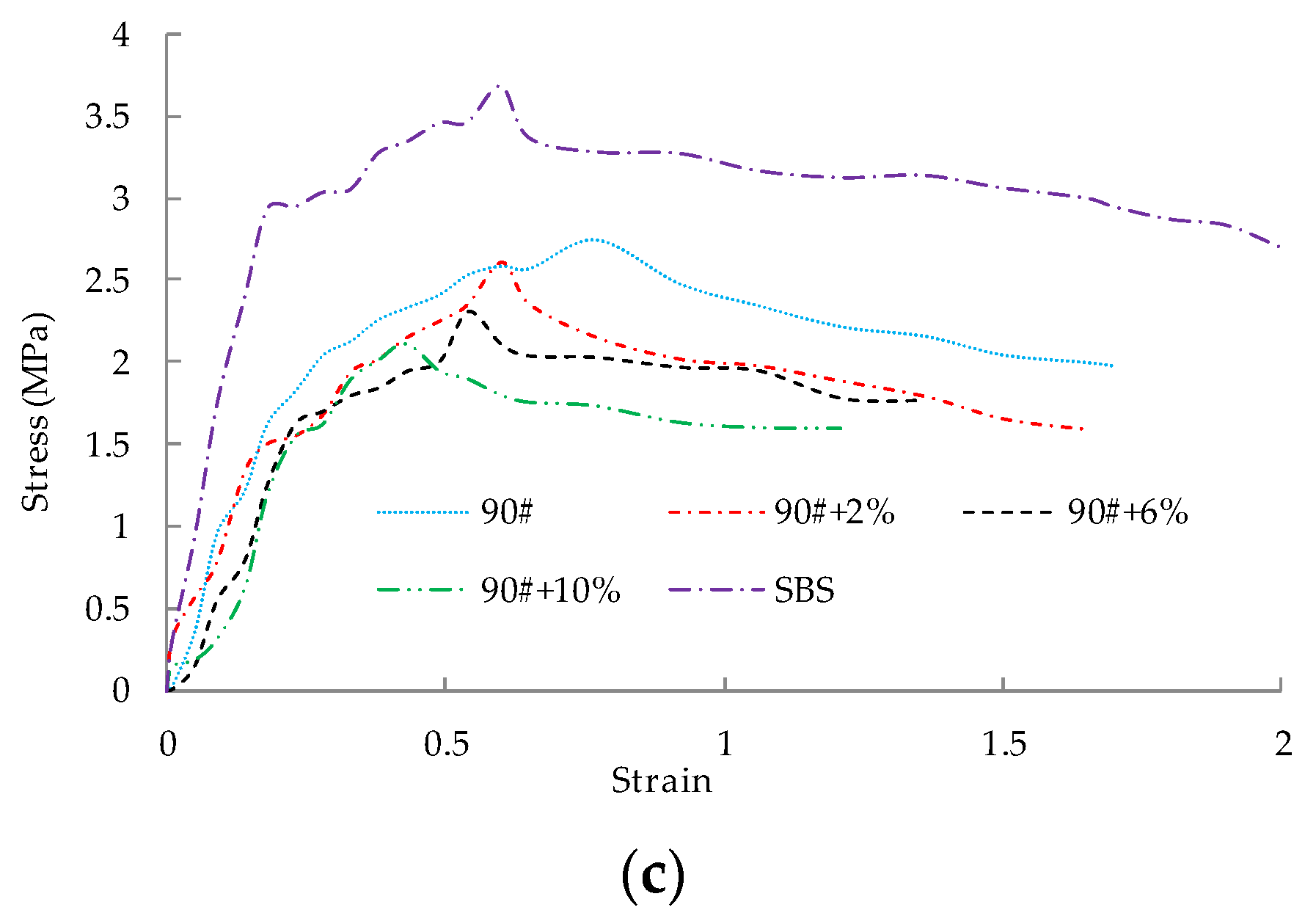
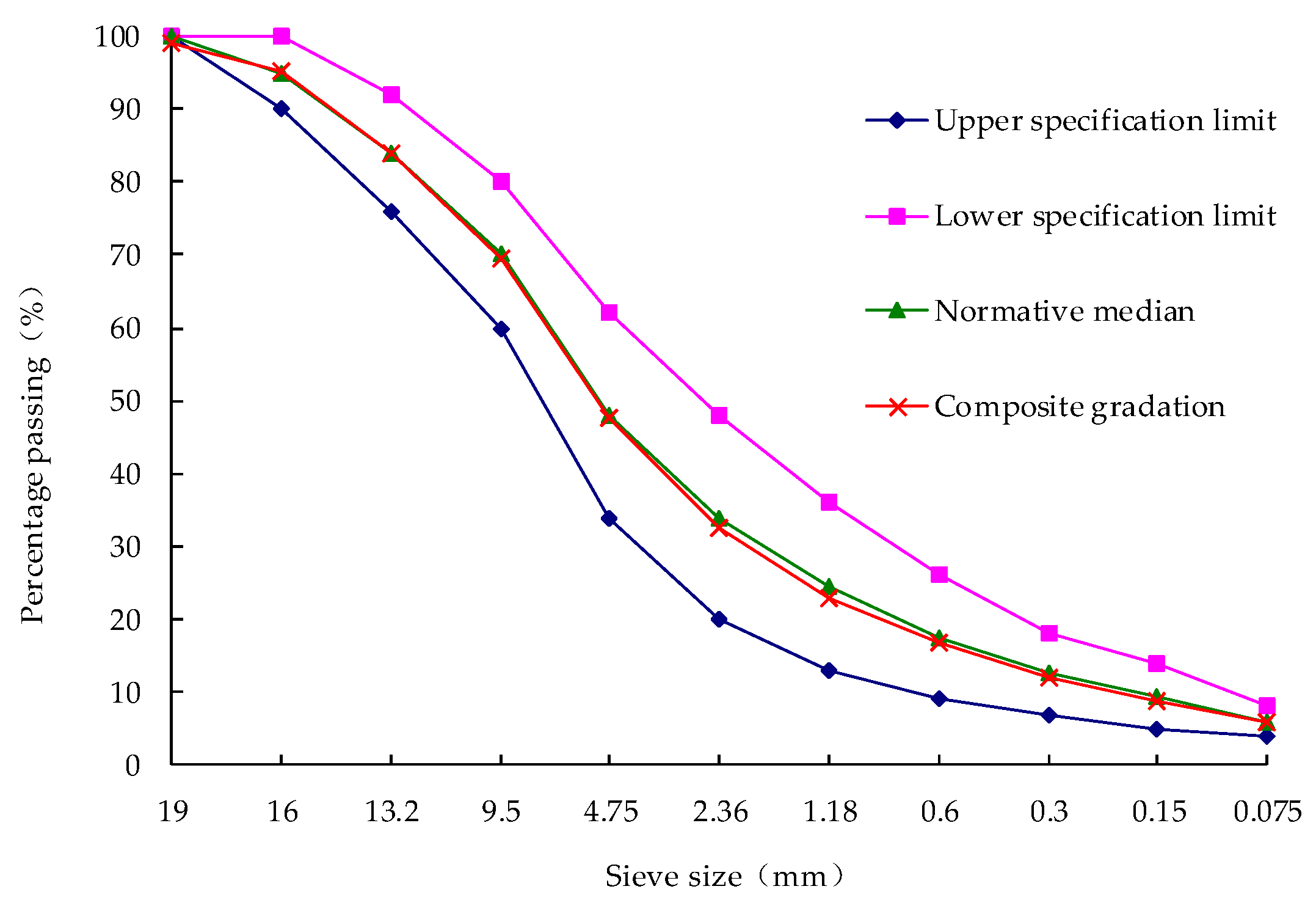
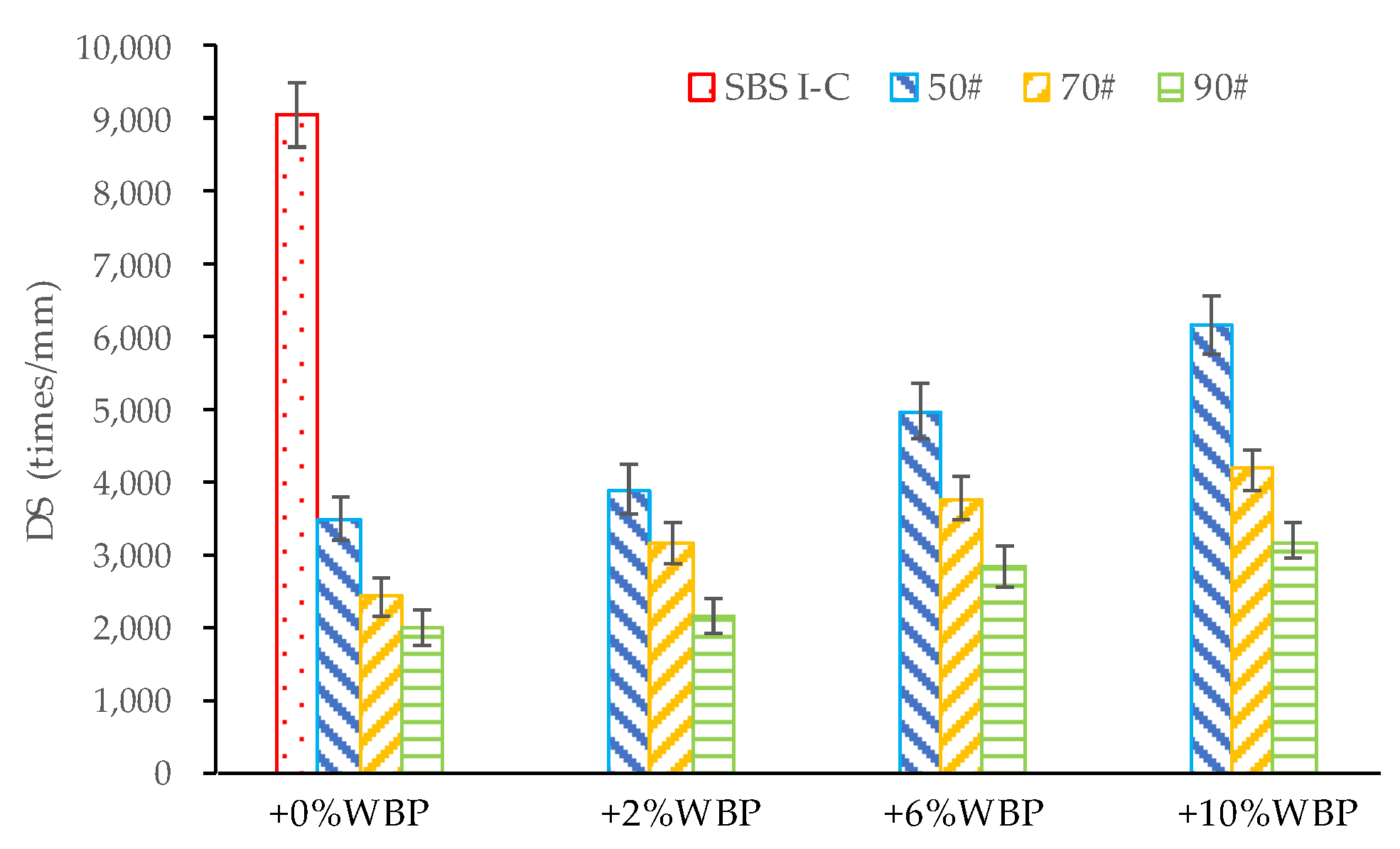
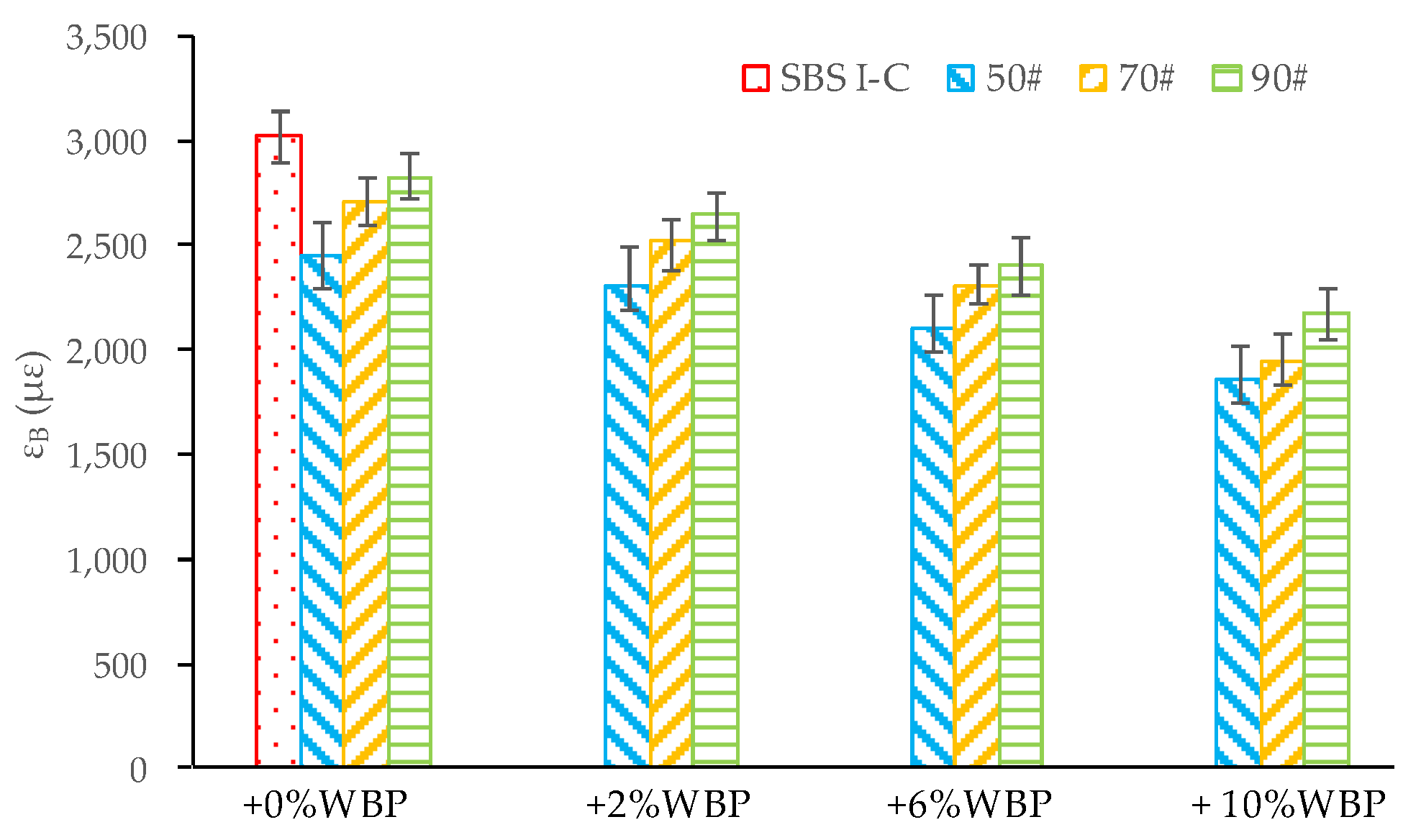
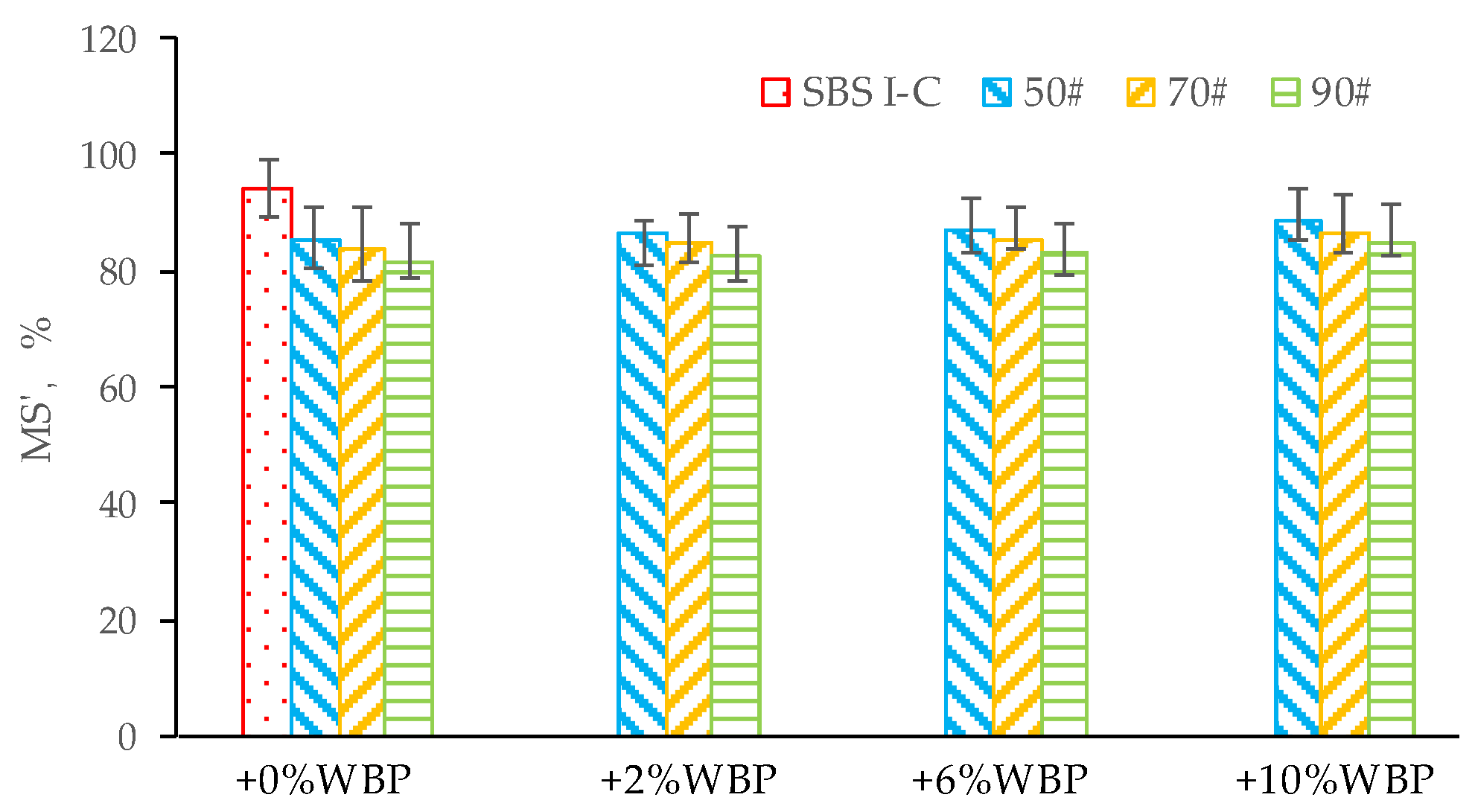
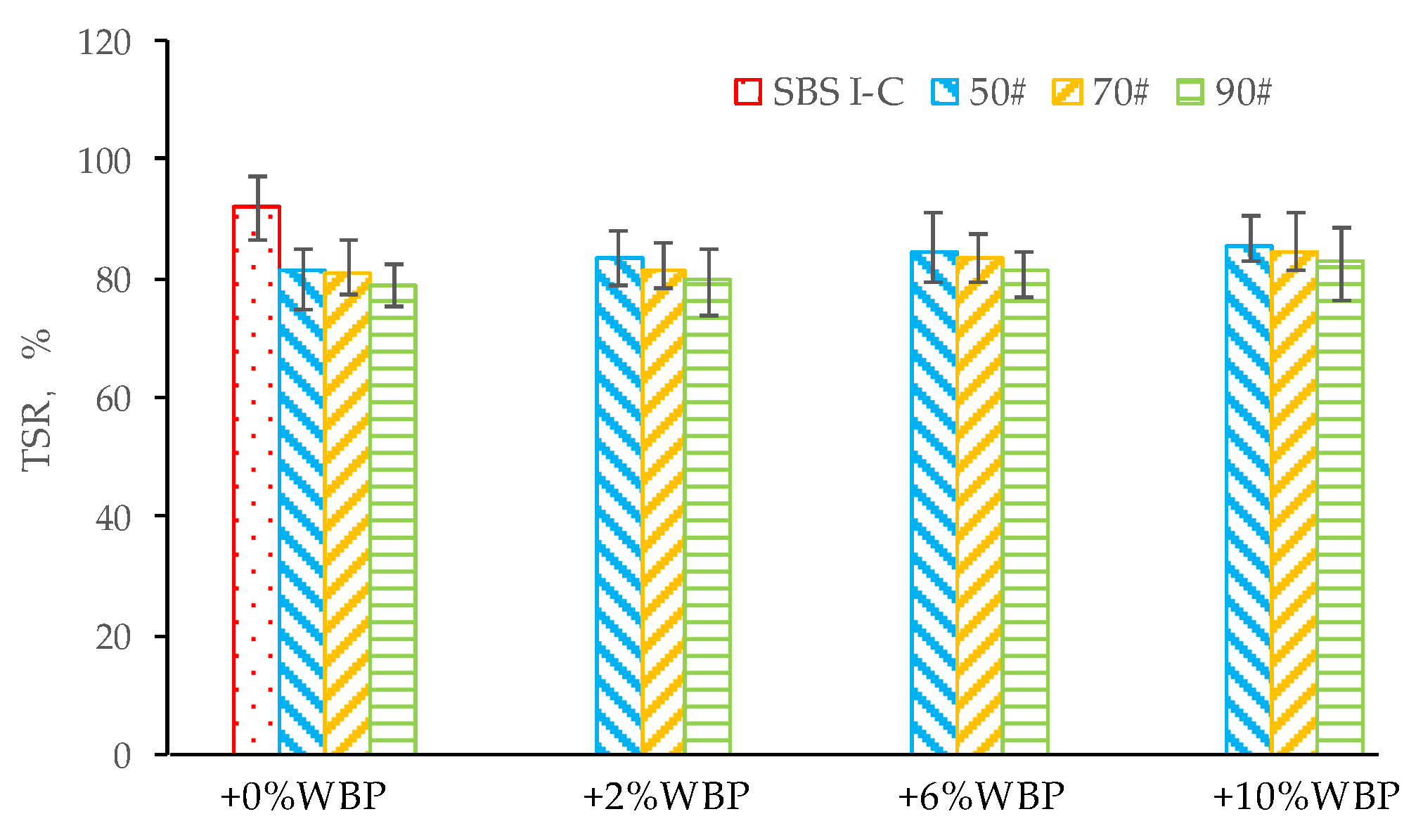
| Test Items | 50# | 70# | 90# | SBS Ι-C | |
|---|---|---|---|---|---|
| Penetration at 25 °C (0.1 mm) | 54.2 | 72.3 | 88.9 | 71.9 | |
| Softening point (°C) | 52.4 | 48.7 | 46.8 | 64.6 | |
| Ductility at 5 °C (cm) | —— | —— | 47.5 | ||
| Ductility at 10 °C (cm) | 17.2 | 28.5 | 45.3 | —— | |
| RTFOT 1 | Mass change (%) | 0.2 | −0.6 | 0.3 | 0.5 |
| Residual penetration ratio at 25 °C (%) | 73.6 | 72.1 | 69.1 | 75.4 | |
| Residual ductility at 5 °C (%) | 9.4 | 16.9 | 20.2 | —— | |
| Residual ductility at 10 °C (%) | —— | —— | —— | 27.3 | |
| Test Items | Test Result | ||||||
|---|---|---|---|---|---|---|---|
| Apparent specific gravity | 2.638 | ||||||
| Sand equivalent of fine aggregate (%) | 60.0 | ||||||
| Angularity of fine aggregate (%) | 52.2 | ||||||
| Sieve test results | |||||||
| Sieve pore (mm) | 4.75 | 2.36 | 1.18 | 0.6 | 0.3 | 0.15 | 0.075 |
| Passing rate (%) | 99.10 | 68.37 | 44.19 | 30.33 | 13.96 | 6.66 | 3.35 |
| Test Items | Test Result | |
|---|---|---|
| Crushing value (%) | 12.5 | |
| Los Angeles Abrasion Loss (%) | 19.4 | |
| Polished Stone Value (PSV) | 43 | |
| Gross volume relative density | 15~20 mm | 2.633 |
| 10~15 mm | 2.606 | |
| 5~10 mm | 2.594 | |
| Apparent specific gravity | 15~20 mm | 2.682 |
| 10~15 mm | 2.687 | |
| 5~10 mm | 2.687 | |
| Water absorption (%) | 15~20 mm | 0.697 |
| 10~15 mm | 1.163 | |
| 5~10 mm | 1.332 | |
| Content of acicular and flaky particles (%) | Mixture | 10.6 |
| >9.5 mm | 7.34 | |
| <9.5 mm | 11.84 | |
| Adhesion to asphalt (grade) | 5 | |
| Test Items | Test Result |
|---|---|
| apparent specific gravity | 2.941 |
| Particle size range < 0.6 mm (%) Particle size range < 0.15 mm (%) Particle size range < 0.075 mm (%) | 99.98 99.82 99.17 |
| Hydrophilicity coefficient | 0.70 |
| Asphalt | 0% + WBP | 2% + WBP | 6% + WBP | 10% + WBP |
|---|---|---|---|---|
| 50# | 0.728 | 0.654 | 0.644 | 0.3325 |
| 70# | 1.155 | 0.9996 | 0.803 | 0.699 |
| 90# | 1.395 | 1.05 | 0.922 | 0.706 |
| SBS | 1.554 | —— | —— | —— |
| Asphalt | 0% + WBP | 2% + WBP | 6% + WBP | 10% + WBP |
|---|---|---|---|---|
| 50# | 4.75 | 4.8 | 4.85 | 4.95 |
| 70# | 4.75 | 4.75 | 4.85 | 4.9 |
| 90# | 4.7 | 4.7 | 4.8 | 4.9 |
| SBS | 4.95 | —— | —— | —— |
Publisher’s Note: MDPI stays neutral with regard to jurisdictional claims in published maps and institutional affiliations. |
© 2022 by the authors. Licensee MDPI, Basel, Switzerland. This article is an open access article distributed under the terms and conditions of the Creative Commons Attribution (CC BY) license (https://creativecommons.org/licenses/by/4.0/).
Share and Cite
Gan, X.; Chen, P.; Yu, B.; Zhang, W. Study on the Performances of Waste Battery Powder Modified Asphalt and Asphalt Mixture. Polymers 2022, 14, 5409. https://doi.org/10.3390/polym14245409
Gan X, Chen P, Yu B, Zhang W. Study on the Performances of Waste Battery Powder Modified Asphalt and Asphalt Mixture. Polymers. 2022; 14(24):5409. https://doi.org/10.3390/polym14245409
Chicago/Turabian StyleGan, Xinli, Peng Chen, Bin Yu, and Wengang Zhang. 2022. "Study on the Performances of Waste Battery Powder Modified Asphalt and Asphalt Mixture" Polymers 14, no. 24: 5409. https://doi.org/10.3390/polym14245409
APA StyleGan, X., Chen, P., Yu, B., & Zhang, W. (2022). Study on the Performances of Waste Battery Powder Modified Asphalt and Asphalt Mixture. Polymers, 14(24), 5409. https://doi.org/10.3390/polym14245409









